TOGAF9.1 版本
TOGAF Version 9.1
(中文版)
The Open Group
�
第1章简介Introduction....................................................................................... 17
1.1 TOGAF文件的结构Structure of the TOGAF Document ...................................................... 17
1.2执行概述Executive Overview ........................................................................... 18
第2章核心概念Core Concepts.................................................................................. 21
2.1什么是TOGAF? What Is TOGAF? ......................................................................... 21
2.2在TOGAF背景环境下,什么是架构? What Is Architecture in the Context of TOGAF? ........................ 21
2.3 TOGAF涉及哪些种类的架构? What Kind of Architecture Does TOGAF Deal with? ........................... 21
2.4架构开发方法Architecture Development Method .......................................................... 21
2.5交付物、制品和构建块Deliverables, Artifacts, and Building Blocks ..................................... 22
2.6企业的连续统一体Enterprise Continuum ................................................................. 23
2.7架构库Architecture Repository ........................................................................ 24
2.8建立和维护企业架构能力Establishing and Maintaining an Enterprise Architecture Capability ............. 25
2.9将架构能力建立为运行实体Establishing the Architecture Capability as an Operational Entity ............ 25
2.10使用TOGAF与其他框架Using TOGAF with Other Frameworks ................................................ 26
第3章定义Definitions........................................................................................ 28
3.1抽象Abstraction ...................................................................................... 28
3.2施动者Actor .......................................................................................... 28
3.3应用Application ...................................................................................... 28
3.4应用架构Application Architecture ..................................................................... 28
3.5应用平台Application Platform ......................................................................... 28
3.6应用平台界面(API)Application Platform Interface .................................................... 28
3.7架构风格Architectural Style .......................................................................... 28
3.8架构Architecture ..................................................................................... 28
3.9架构构建块(ABB)Architecture Building Block ......................................................... 29
3.10架构连续统一体Architecture Continuum ................................................................ 29
3.11架构开发方法(ADM)Architecture Development Method .................................................. 29
3.12架构域Architecture Domain ........................................................................... 29
3.13架构框架Architecture Framework ...................................................................... 29
3.14架构治理Architecture Governance ..................................................................... 29
3.15架构全景Architecture Landscape ...................................................................... 29
3.16架构原则Architecture Principles ..................................................................... 29
3.17架构愿景Architecture Vision ......................................................................... 29
3.18制品Artifact ........................................................................................ 30
3.19基线Baseline ........................................................................................ 30
3.20无边界信息流Boundary less Information Flow .......................................................... 30
3.21构建块Building Block ................................................................................ 30
3.22业务架构Business Architecture ....................................................................... 30
3.23业务功能Business Function ........................................................................... 30
3.24业务治理Business Governance ......................................................................... 30
3.25业务服务Business Service ............................................................................ 31
3.26能力Capability ...................................................................................... 31
3.27能力架构Capability Architecture ..................................................................... 31
3.28能力增量Capability Increment ........................................................................ 31
3.29沟通和利益攸关者管理Communications and Stakeholder Management ....................................... 31
3.30关注点Concerns ...................................................................................... 31
3.31约束Constraint ...................................................................................... 31
3.32数据架构Data Architecture ........................................................................... 31
3.33交付物Deliverable ................................................................................... 31
3.34企业Enterprise ...................................................................................... 32
3.35企业的连续统一体Enterprise Continuum ................................................................ 32
3.36基础架构Foundation Architecture ..................................................................... 32
3.37框架Framework ....................................................................................... 32
3.38差距Gap ............................................................................................. 32
3.39治理Governance ...................................................................................... 32
3.40信息Information ..................................................................................... 32
3.41信息技术(IT)Information Technology ................................................................ 32
3.42互用性Interoperability .............................................................................. 33
3.43逻辑的Logical ....................................................................................... 33
3.44元数据Metadata ...................................................................................... 33
3.45元模型Metamodel ..................................................................................... 33
3.46方法Method .......................................................................................... 33
3.47方法论Methodology ................................................................................... 33
3.48模型Model ........................................................................................... 33
3.49建模Modeling ........................................................................................ 34
3.50目的Objective ....................................................................................... 34
3.51特征模式Patterns .................................................................................... 34
3.52绩效管理Performance Management ...................................................................... 34
�
3.53物理的Physical ...................................................................................... 34
3.54平台Platform ........................................................................................ 34
3.55平台服务Platform Service ............................................................................ 34
3.56原则Principle ....................................................................................... 34
3.57参考模型(RM)Reference Model ....................................................................... 34
3.58存储库Repository .................................................................................... 35
3.59需求Requirement ..................................................................................... 35
3.60路线图Roadmap ....................................................................................... 35
3.61角色Role ............................................................................................ 35
3.62分部架构Segment Architecture ........................................................................ 35
3.63面向服务Service Orientation ......................................................................... 35
3.64面向服务架构(SOA)Service Oriented Architecture .................................................... 35
3.65解决方案架构Solution Architecture ................................................................... 36
3.66解决方案构建块(SBB)Solution Building Block ........................................................ 36
3.67解决方案连续统一体Solutions Continuum ............................................................... 36
3.68利益攸关者Stakeholder ............................................................................... 36
3.69标准信息库(SIB)Standards Information Base ......................................................... 36
3.70战略架构Strategic Architecture ...................................................................... 36
3.71目标架构Target Architecture ......................................................................... 36
3.72架构视图分类法Taxonomy of Architecture Views ........................................................ 36
3.73技术架构Technology Architecture ..................................................................... 37
3.74过渡架构Transition Architecture ..................................................................... 37
3.75视图View ............................................................................................ 37
3.76视角Viewpoint ....................................................................................... 37
3.77工作包Work Package .................................................................................. 37
第4章发布说明Release Notes.................................................................................. 38
4.1 TOGAF9的新特征是什么?What’s New in TOGAF 9? ....................................................... 38
4.1.1本版中应用的变更Changes Applied in this Edition................................................. 39
4.2TOGAF9的效益The Benefits of TOGAF 9 .................................................................. 40
4.3TOGAF8.1.1结构到TOGAF9的映射Mapping of the TOGAF 8.1.1 Structure to TOGAF 9 .......................... 41
4.4TOGAF9结构到TOGAF8.1.1的映射Mapping of TOGAF 9 Structure to TOGAF 8.1.1 .............................. 42
4.5使用TOGAF Using TOGAF ................................................................................ 43
4.5.1使用条件Conditions of Use....................................................................... 43
4.5.2 TOGAF花费多少成本?How Much Does TOGAF Cost?................................................... 44
4.5.3下载Downloads................................................................................... 44
4.6为什么加入The Open Group? Why Join The Open Group? ................................................... 44
第5章简介 Introduction...................................................................................... 46
5.1 ADM概述 ADM Overview ................................................................................ 46
5.1.1 ADM、企业的连续统一体和架构库 The ADM, Enterprise Continuum, and Architecture Repository....... 46
5.1.2 ADM和基础架构 The ADM and the Foundation Architecture.......................................... 47
5.1.3 ADM和支持指南和技巧 ADM and Supporting Guidelines and Techniques............................... 47
5.2架构开发周期 Architecture Development Cycle .......................................................... 47
5.2.1关键点 Key Points............................................................................... 47
5.2.2基本结构 Basic Structure........................................................................ 48
5.3 ADM的适应性调整 Adapting the ADM .................................................................... 49
5.4架构治理 Architecture Governance ..................................................................... 50
5.5界定架构的范围 Scoping the Architecture .............................................................. 51
5.5.1广度 Breadth.................................................................................... 52
5.5.2深度 Depth...................................................................................... 52
5.5.3时间区间 Time Period............................................................................ 53
5.5.4架构域 Architecture Domains..................................................................... 53
5.6架构综合 Architecture Integration .................................................................... 54
5.7概要总结 Summary ..................................................................................... 54
第6章预备阶段 Preliminary Phase............................................................................. 56
6.1目的 Objectives ...................................................................................... 56
6.2实施途径 Approach .................................................................................... 57
6.2.1企业Enterprise.................................................................................. 57
6.2.2组织的背景环境 Organizational Context........................................................... 57
6.2.3架构工作的需求 Requirements for Architecture Work............................................... 58
6.2.4原则 Principles................................................................................. 58
6.2.5管理框架 Management Frameworks.................................................................. 59
6.2.6使管理框架相关联 Relating the Management Frameworks............................................. 60
6.2.7企业架构/业务变革成熟度评估规划 Planning for Enterprise Architecture/Business Change Maturity
Evaluation........................................................................................... 61
6.3输入 Inputs .......................................................................................... 61
6.3.1企业的外部参考资料 Reference Materials External to the Enterprise............................... 61
6.3.2非架构输入 Non-Architectural Inputs............................................................. 61
�
6.3.3架构输入 Architectural Inputs................................................................... 62
6.4步骤 Steps ........................................................................................... 62
6.4.1界定受影响的企业组织的范围 Scope the Enterprise Organizations Impacted.......................... 63
6.4.2确认治理和支持框架 Confirm Governance and Support Frameworks.................................... 63
6.4.3定义并建立企业架构团队和组织 Define and Establish Enterprise Architecture Team and Organization. 63
6.4.4识别和建立架构原则 Identify and Establish Architecture Principles............................... 64
6.4.5剪裁TOGAF以及其他选定的架构框架(如果有) Tailor TOGAF and, if Any, Other Selected Architecture
Framework(s)......................................................................................... 64
6.4.6实施架构的工具 Implement Architecture Tools..................................................... 64
6.5输出 Outputs ......................................................................................... 64
第7章阶段A:架构愿景 Phase A: Architecture Vision............................................................ 66
7.1目的 Objectives ...................................................................................... 66
7.2实施途径 Approach .................................................................................... 66
7.2.1概述 General.................................................................................... 66
7.2.2创建架构愿景 Creating the Architecture Vision................................................... 67
7.2.3业务场景 Business Scenarios..................................................................... 67
7.3输入 Inputs .......................................................................................... 68
7.3.1企业外部的参考资料 Reference Materials External to the Enterprise............................... 68
7.3.2非架构输入 Non-Architectural Inputs............................................................. 68
7.3.3架构输入 Architectural Inputs................................................................... 68
7.4步骤 Steps ........................................................................................... 68
7.4.1建立架构项目 Establish the Architecture Project................................................. 69
7.4.2识别利益攸关者、关注点和业务需求 Identify Stakeholders, Concerns, and Business Requirements .......... 69
7.4.3确认和详细阐述业务目标、业务驱动因素和约束 Confirm and Elaborate Business Goals, Business Drivers, and
Constraints ........................................................................................... 70
7.4.4评价业务能力 Evaluate Business Capabilities..................................................... 70
7.4.5评估业务转型准备度 Assess Readiness for Business Transformation................................. 70
7.4.6定义范围 Define Scope........................................................................... 70
7.4.7确认和详细阐述架构原则,包括业务原则 Confirm and Elaborate Architecture Principles, including Business
Principles............................................................................................ 71
7.4.8开发架构愿景 Develop Architecture Vision........................................................ 71
7.4.9定义目标架构价值主张和KPI Define the Target Architecture Value Propositions and KPIs........... 71
7.4.10识别业务转型风险和缓解活动 Identify the Business Transformation Risks and Mitigation Activities ...... 72
7.4.11开发架构工作说明书;确保批准 Develop Statement of Architecture Work; Secure Approval........... 72
7.5输出 Outputs ......................................................................................... 72
第8章 阶段B:业务架构 Phase B: Business Architecture......................................................... 74
8.1目的 Objectives ...................................................................................... 74
8.2实施途径 Approach .................................................................................... 74
8.2.1概述 General.................................................................................... 74
8.2.2开发基线描述 Developing the Baseline Description................................................ 75
8.2.3业务建模 Business Modeling...................................................................... 76
8.2.4架构存储库 Architecture Repository.............................................................. 77
8.3输入 Inputs .......................................................................................... 77
8.3.1企业外部参考资料 Reference Materials External to the Enterprise................................. 78
8.3.2非架构输入 Non-Architectural Inputs............................................................. 78
8.3.3架构输入 Architectural Inputs................................................................... 78
8.4步骤 Steps ........................................................................................... 79
8.4.1选择参考模型、视角和工具 Select Reference Models, Viewpoints, and Tools......................... 80
8.4.2开发基线业务架构描述 Develop Baseline Business Architecture Description......................... 82
8.4.3开发目标业务架构描述 Develop Target Business Architecture Description........................... 82
8.4.4进行差距分析 Perform Gap Analysis............................................................... 83
8.4.5定义候选路线图组件 Define Candidate Roadmap Components.......................................... 83
8.4.6化解贯穿整个架构全景中的影响 Resolve Impacts Across the Architecture Landscape.................. 83
8.4.7进行正式的利益攸关者审视 Conduct Formal Stakeholder Review...................................... 83
8.4.8最终确定业务架构 Finalize the Business Architecture............................................. 83
8.4.9创建架构定义文件 Create Architecture Definition Document........................................ 84
8.5输出 Outputs ......................................................................................... 84
第9章阶段C:信息系统架构 Phase C: Information Systems Architectures.......................................... 86
9.1目的 Objectives ...................................................................................... 86
9.2实施途径 Approach .................................................................................... 86
9.3输入 Inputs .......................................................................................... 87
9.3.1企业外的参考资料 Reference Materials External to the Enterprise................................. 87
9.3.2非架构输入 Non-Architectural Inputs............................................................. 87
9.3.3架构输入 Architectural Inputs................................................................... 87
9.4步骤 Steps ........................................................................................... 88
9.5输出 Outputs ......................................................................................... 88
第10章阶段C:信息系统架构——数据架构 Phase C: Information Systems Architectures — Data Architecture ............. 89
�
10.1目的 Objectives ..................................................................................... 89
10.2实施途径 Approach ................................................................................... 89
10.2.1数据架构的考量因素 Key Considerations for Data Architecture.................................... 89
10.2.2架构存储库 Architecture Repository............................................................. 90
10.3输入 Inputs ......................................................................................... 90
10.3.1企业外的参考资料 Reference Materials External to the Enterprise................................ 90
10.3.2非架构输入 Non-Architectural Inputs............................................................ 90
10.3.3架构输入 Architectural Inputs.................................................................. 90
10.4步骤 Steps .......................................................................................... 91
10.4.1选择参考模型、视角和工具 Select Reference Models, Viewpoints, and Tools........................ 92
10.4.2开发基线数据架构描述 Develop Baseline Data Architecture Description............................ 94
10.4.3开发目标数据架构描述 Develop Target Data Architecture Description.............................. 94
10.4.4进行差距分析 Perform Gap Analysis.............................................................. 95
10.4.5定义候选路线图组件Define Candidate Roadmap Components.......................................... 95
10.4.6解析贯穿整个架构全景中的影响 Resolve Impacts Across the Architecture Landscape................. 95
10.4.7进行正式的利益攸关者审视 Conduct Formal Stakeholder Review..................................... 95
10.4.8最终确定数据架构 Finalize the Data Architecture................................................ 96
10.4.9创建架构定义文件Create Architecture Definition Document........................................ 96
10.5输出 Outputs ........................................................................................ 96
第11章阶段C:信息系统架构——应用架构Phase C: Information Systems Architectures — Application Architecture.. 98
11.1目的 Objectives ..................................................................................... 98
11.2实施途径 Approach ................................................................................... 98
11.2.1架构存储库 Architecture Repository............................................................. 98
11.3输入 Inputs ......................................................................................... 98
11.3.1企业外部参考资料 Reference Materials External to the Enterprise................................ 98
11.3.2非架构输入 Non-Architectural Inputs............................................................ 98
11.3.3架构输入 Architectural Inputs.................................................................. 99
11.4步骤 Steps ......................................................................................... 100
11.4.1选择参考模型、视角和工具 Select Reference Models, Viewpoints, and Tools....................... 100
11.4.2开发基线应用架构描述 Develop Baseline Application Architecture Description.................... 103
11.4.3开发目标应用架构描述 Develop Target Application Architecture Description...................... 103
11.4.4进行差距分析 Perform Gap Analysis............................................................. 103
11.4.5定义候选路线图组件 Define Candidate Roadmap Components........................................ 103
11.4.6化解贯穿整个架构全景中的影响 Resolve Impacts Across the Architecture Landscape................ 104
11.4.7进行正式的利益攸关者审视 Conduct Formal Stakeholder Review.................................... 104
11.4.8最终确定应用架构 Finalize the Application Architecture........................................ 104
11.4.9创建架构定义文件 Create Architecture Definition Document...................................... 104
11.5输出 Outputs ....................................................................................... 104
第12章阶段D:技术架构 Phase D: Technology Architecture...................................................... 107
12.1目的 Objectives .................................................................................... 107
12.2实施途径 Approach .................................................................................. 107
12.2.1架构存储库 Architecture Repository............................................................ 107
12.3输入 Inputs ........................................................................................ 108
12.3.1企业外部参考资料 Reference Materials External to the Enterprise............................... 108
12.3.2非架构输入 Non-Architectural Inputs........................................................... 108
12.3.3架构输入 Architectural Inputs................................................................. 108
12.4步骤 Steps ......................................................................................... 109
12.4.1选择参考模型、视角和工具 Select Reference Models, Viewpoints, and Tools....................... 110
12.4.2开发基线技术架构描述 Develop Baseline Technology Architecture Description..................... 113
12.4.3开发目标技术架构描述 Develop Target Technology Architecture Description....................... 113
12.4.4进行差距分析 Perform Gap Analysis............................................................. 113
12.4.5定义候选路线图组件 Define Candidate Roadmap Components........................................ 114
12.4.6化解贯穿整个架构全景中的影响 Resolve Impacts Across the Architecture Landscape................ 114
12.4.7进行正式的利益攸关者审视 Conduct Formal Stakeholder Review.................................... 114
12.4.8最终确定技术架构 Finalize the Technology Architecture......................................... 114
12.4.9创建架构定义文件 Create Architecture Definition Document...................................... 114
12.5输出 Outputs ....................................................................................... 115
12.6附言 Postscript .................................................................................... 116
第13章阶段E:机会和解决方案 Phase E: Opportunities & Solutions.............................................. 117
13.1目的 Objectives .................................................................................... 117
13.2实施途径 Approach .................................................................................. 117
13.3输入 Inputs ........................................................................................ 118
13.3.1企业外部参考资料 Reference Materials External to the Enterprise............................... 118
13.3.2非架构输入 Non-Architectural Inputs........................................................... 118
13.3.3架构输入Architectural Inputs.................................................................. 118
13.4步骤 Steps ......................................................................................... 119
13.4.1确定/确认关键的公司级变革属性 Determine/Confirm Key Corporate Change Attributes............... 120
�
13.4.2确定关于实施的业务约束 Determine Business Constraints for Implementation...................... 120
13.4.3审视和合并阶段B〜D的差距分析结果 Review and Consolidate Gap Analysis Results from Phases B to D ..... 120
13.4.4审视所有相关业务功能的合并需求 Review Consolidated Requirements Across Related Business Functions ... 121
13.4.5合并和调和互用性需求 Consolidate and Reconcile Interoperability Requirements.................. 121
13.4.6细化和确认依赖性 Refine and Validate Dependencies............................................. 121
13.4.7确认业务转型的准备度和风险 Confirm Readiness and Risk for Business Transformation............. 121
13.4.8制定实施和迁移战略 Formulate Implementation and Migration Strategy............................ 122
13.4.9识别主要工作包并将其分组 Identify and Group Major Work Packages............................... 122
13.4.10识别过渡架构 Identify Transition Architectures............................................... 123
13.4.11创建架构路线图及实施和迁移计划 Create the Architecture Roadmap & Implementation and Migration Plan . 123
13.5输出 Outputs ....................................................................................... 123
第14章阶段F:迁移规划 Phase F: Migration Planning........................................................... 126
14.1目的 Objectives .................................................................................... 126
14.2实施途径 Approach .................................................................................. 126
14.3输入 Inputs ........................................................................................ 127
14.3.1企业外部参考资料Reference Materials External to the Enterprise................................ 127
14.3.2非架构输入 Non-Architectural Inputs........................................................... 127
14.3.3架构输入 Architectural Inputs................................................................. 127
14.4步骤 Steps ......................................................................................... 128
14.4.1为实施和迁移计划确认管理框架交互 Confirm Management Framework Interactions for the Implementation
and Migration Plan.................................................................................. 129
14.4.2为每个工作包指派业务价值 Assign a Business Value to Each Work Package......................... 129
14.4.3评估资源需求、项目时间安排和可用性/交付载体 Estimate Resource Requirements, Project Timings, and
Availability/Delivery Vehicle....................................................................... 130
14.4.4通过成本/效益评估和风险验证对迁移项目进行优先级排序 Prioritize the Migration Projects through the
Conduct of a Cost/Benefit Assessment and Risk Validation............................................ 130
14.4.5确认架构路线图并更新架构定义文件 Confirm Architecture Roadmap and Update Architecture Definition
Document............................................................................................ 130
14.4.6生成实施和迁移计划 Generate the Implementation and Migration Plan............................. 131
14.4.7完成架构开发周期并记录经验教训 Complete the Architecture Development Cycle and Document Lessons
Learned............................................................................................. 131
14.5输出 Outputs ....................................................................................... 131
第15章阶段G:实施治理Phase G: Implementation Governance..................................................... 133
15.1目的 Objectives .................................................................................... 133
15.2实施途径 Approach .................................................................................. 133
15.3输入 Inputs ........................................................................................ 134
15.3.1企业外的参考资料 Reference Materials External to the Enterprise............................... 134
15.3.2非架构输入 Non-Architectural Inputs........................................................... 134
15.3.3架构输入 Architectural Inputs................................................................. 134
15.4步骤 Steps ......................................................................................... 135
15.4.1利用开发管理来确认部署的范围和优先级 Confirm Scope and Priorities for Deployment with Development Management
.................................................................................................... 135
15.4.2识别部署资源和技能 Identify Deployment Resources and Skills................................... 136
15.4.3指导解决方案部署的开发 Guide Development of Solutions Deployment.............................. 136
15.4.4执行企业架构合规审视 Perform Enterprise Architecture Compliance Reviews....................... 137
15.4.5实施业务和IT运行 Implement Business and IT Operations......................................... 137
15.4.6执行实施后审视并结束实施 Perform Post-Implementation Review and Close the Implementation .............. 137
15.5输出 Outputs ....................................................................................... 137
第16章阶段H:架构变更管理Phase H: Architecture Change Management............................................ 138
16.1目的 Objectives .................................................................................... 138
16.2实施途径 Approach .................................................................................. 138
16.2.1变更的驱动因素 Drivers for Change............................................................. 139
16.2.2企业架构变更管理流程 Enterprise Architecture Change Management Process........................ 140
16.2.3维护vs架构再设计的指南 Guidelines for Maintenance versus Architecture Redesign................ 141
16.3输入 Inputs ........................................................................................ 142
16.3.1企业外部参考资料 Reference Materials External to the Enterprise............................... 142
16.3.2非架构输入 Non-Architectural Inputs........................................................... 142
16.3.3架构输入 Architectural Inputs................................................................. 142
16.4步骤 Steps ......................................................................................... 143
16.4.1建立价值实现流程 Establish Value Realization Process.......................................... 143
16.4.2部署监控工具 Deploy Monitoring Tools.......................................................... 144
16.4.3管理风险 Manage Risks......................................................................... 144
16.4.4为架构变更管理提供分析 Provide Analysis for Architecture Change Management.................... 144
16.4.5开发满足绩效目标的变更需求 Develop Change Requirements to Meet Performance Targets............ 144
16.4.6管理治理流程 Manage Governance Process........................................................ 144
16.4.7为实施变更启动流程 Activate the Process to Implement Change................................... 144
�
16.5输出 Outputs ....................................................................................... 145
第17章ADM架构需求管理ADM Architecture Requirements Management.............................................. 146
17.1目的 Objectives .................................................................................... 146
17.2实施途径 Approach .................................................................................. 146
17.2.1概述 General.................................................................................. 146
17.2.2需求开发 Requirements Development............................................................. 147
17.2.3资源 Resources................................................................................ 147
17.3输入 Inputs ........................................................................................ 148
17.4步骤 Steps ......................................................................................... 148
17.5输出 Outputs ....................................................................................... 149
第18章简介Introduction..................................................................................... 151
18.1 ADM的适应性调整指南 Guidelines for Adapting the ADM Process ....................................... 151
18.2架构开发技巧 Techniques for Architecture Development ............................................... 151
18.3配合不同架构风格使用TOGAF Using TOGAF with Different Architectural Styles .......................... 151
第19章对ADM应用迭代 Applying Iteration to the ADM.......................................................... 153
19.1概述 Overview ...................................................................................... 153
19.2迭代周期 Iteration Cycles .......................................................................... 153
19.3架构介入的类别 Classes of Architecture Engagement .................................................. 154
19.4架构开发的途径 Approaches to Architecture Development .............................................. 156
19.5迭代考量因素 Iteration Considerations .............................................................. 156
19.5.1 ADM周期之间的迭代 Iteration between ADM Cycles............................................... 157
19.5.2在一个ADM周期内的迭代 Iteration within an ADM Cycle........................................... 157
19.6结论 Conclusions ................................................................................... 159
第20章贯穿架构全景应用ADM Applying the ADM across the Architecture Landscape............................... 160
20.1概述 Overview ...................................................................................... 160
20.2架构全景 Architecture Landscape .................................................................... 160
20.3绘编架构全景以理解企业的状态 Organizing the Architecture Landscape to Understand the State of the
Enterprise ............................................................................................. 161
20.4开发不同层级的架构 Developing Architectures at Different Levels .................................... 161
第21章安保架构和ADM Security Architecture and the ADM..................................................... 163
21.1概述 Overview ...................................................................................... 163
21.2简介 Introduction .................................................................................. 163
21.3关于架构领域安保性的引导 Guidance on Security for the Architecture Domains ......................... 163
21.4 ADM架构需求管理 ADM Architecture Requirements Management .......................................... 164
21.5预备阶段 Preliminary Phase ......................................................................... 165
21.5.1安保输入 Security Inputs...................................................................... 166
21.5.2安保输出 Security Outputs..................................................................... 166
21.6阶段A:架构愿景 Phase A: Architecture Vision ........................................................ 166
21.6.1安保输入 Security Inputs...................................................................... 167
21.6.2安保输出 Security Outputs..................................................................... 167
21.7阶段B:业务架构 Phase B: Business Architecture ...................................................... 168
21.7.1安保输入 Security Inputs...................................................................... 169
21.7.2安保输出 Security Outputs..................................................................... 169
21.8阶段C:信息系统架构 Phase C: Information Systems Architectures ...................................... 170
21.8.1安保输入 Security Inputs...................................................................... 171
21.8.2安保输出 Security Outputs..................................................................... 172
21.9阶段D:技术架构 Phase D: Technology Architecture .................................................... 172
21.9.1安保输入 Security Inputs...................................................................... 173
21.9.2安保输出 Security Outputs..................................................................... 173
21.10阶段E:机会和解决方案 Phase E: Opportunities & Solutions ........................................... 174
21.11阶段F:迁移规划 Phase F: Migration Planning ........................................................ 174
21.12阶段G:实施治理 Phase G: Implementation Governance ................................................. 174
21.13阶段H:架构变更管理 Phase H: Architecture Change Management ........................................ 175
21.14参考文献 References ............................................................................... 176
第22章使用TOGAF定义和治理SOA Using TOGAF to Define & Govern SOAs.......................................... 177
22.1概述 Overview ...................................................................................... 177
22.2简介 Introduction .................................................................................. 177
22.3 SOA定义 SOA Definition ............................................................................ 177
22.4 SOA特征 SOA Features .............................................................................. 178
22.5企业架构和SOA Enterprise Architecture and SOA ..................................................... 178
22.6 SOA和层级 SOA and Levels ......................................................................... 179
22.6.1实施规范的细节层级 Level of Detail of Implementation Specification............................ 179
22.6.2不同层级上的SOA活动 SOA Activities at Different Levels........................................ 179
22.7将TOGAF用于SOA Using TOGAF for SOA ................................................................ 180
22.7.1预备阶段 Preliminary Phase.................................................................... 180
22.7.2阶段A:架构愿景 Phase A: Architecture Vision................................................... 182
22.7.3架构开发:阶段B、C和D Architecture Development: Phases B, C, and D........................... 183
�
22.8概要总结 ........................................................................................... 187
第23章架构原则Architecture Principles...................................................................... 189
23.1简介Introduction ................................................................................... 189
23.2架构原则的特征 Characteristics of Architecture Principles .......................................... 189
23.3架构原则的组成部分 Components of Architecture Principles ........................................... 189
23.4开发架构原则 Developing Architecture Principles .................................................... 190
23.4.1原则的质量 Qualities of Principles............................................................ 190
23.5架构原则的应用 Applying Architecture Principles .................................................... 191
23.6架构原则示例集 Example Set of Architecture Principles .............................................. 192
23.6.1业务原则 Business Principles.................................................................. 192
23.6.2数据原则 Data Principles...................................................................... 195
23.6.3应用原则 Application Principles............................................................... 198
23.6.4技术原则 Technology Principles................................................................ 199
第24章利益攸关者管理Stakeholder Management................................................................. 201
24.1简介 Introduction .................................................................................. 201
24.2利益攸关者管理的实施途径 Approach to Stakeholder Management ........................................ 201
24.3利益攸关者管理流程的步骤 Steps in the Stakeholder Management Process ............................... 202
24.3.1识别利益攸关者 Identify Stakeholders.......................................................... 202
24.3.2对利益攸关者职位分类 Classify Stakeholder Positions........................................... 203
24.3.3确定利益攸关者管理途径 Determine Stakeholder Management Approach.............................. 204
24.3.4剪裁工作交付物 Tailor Engagement Deliverables................................................. 204
24.4利益攸关者映射模板 Template Stakeholder Map ........................................................ 204
第25章架构特征模式 Architecture Patterns................................................................... 207
25.1简介 Introduction .................................................................................. 207
25.1.1背景 Background.............................................................................. 207
25.1.2特征模式内容 Content of a Pattern............................................................. 207
25.1.3术语 Terminology.............................................................................. 209
25.1.4使用中的架构特征模式 Architecture Patterns in Use............................................. 210
25.2美国财政部架构开发指导(TADG) US Treasury Architecture Development Guidance (TADG) ................ 210
25.2.I TADG特征模式内容 TADG Pattern Content........................................................ 210
25.2.2 TADG架构特征模式 TADG Architecture Patterns.................................................. 211
25.3 IBM电子商务特征模式 IBM Patterns for e-Business ................................................... 211
25.4若干特征模式资源 Some Pattern Resources ............................................................ 212
第26章业务场景和业务目标Business Scenarios and Business Goals.............................................. 214
26.1简介 Introduction .................................................................................. 214
26.2业务场景的益处 Benefits of Business Scenarios ...................................................... 214
26.3创建业务场景 Creating the Business Scenario ........................................................ 215
26.3.1整体流程 Overall Process...................................................................... 215
26.3.2收集 Gathering................................................................................ 216
26.3.3分析 Analyzing................................................................................ 217
26.3.4审查 Reviewing................................................................................ 217
26.4业务场景内容 Contents of a Business Scenario ....................................................... 217
26.5对业务场景的贡献 Contributions to the Business Scenario ............................................ 218
26.6业务场景和TOGAF ADM Business Scenarios and the TOGAF ADM .......................................... 219
26.7开发业务场景 Developing Business Scenarios ......................................................... 219
26.7.1一般指南 General Guidelines................................................................... 219
26.7.2每个领域需要提问的问题 Questions to Ask for Each Area......................................... 220
26.8业务场景文档 Business Scenario Documentation ....................................................... 222
26.8.1文本文档 Textual Documentation................................................................ 222
26.9目标和目的指南 Guidelines on Goals and Objectives .................................................. 222
26.9.1目标的重要性 Importance of Goals.............................................................. 222
26.9.2SMART目的的重要性 Importance of SMART Objectives.............................................. 223
26.9.3目标和目的类别 Categories of Goals and Objectives............................................. 224
26.10概要总结 Summary .................................................................................. 227
第27章差距分析Gap Analysis................................................................................. 228
27.1简介 Introduction .................................................................................. 228
27.2建议的步骤 Suggested Steps ......................................................................... 228
27.3示例 Example ....................................................................................... 229
第28章迁移规划技巧 Migration Planning Techniques........................................................... 230
28.1实施因素评估和推论矩阵 ............................................................................. 230
28.2合并的差距、解决方案和依赖性矩阵 Consolidated Gaps, Solutions, & Dependencies Matrix ............... 230
28.3架构定义增量表Architecture Definition Increments Table ............................................. 231
28.4过渡架构状态演进表 Transition Architecture State Evolution Table ................................... 231
28.5业务价值评估技巧Business Value Assessment Technique ................................................ 231
第29章互用性需求 Interoperability Requirements............................................................. 233
29.1综述 overview ...................................................................................... 233
29.2定义互用性 Defining Interoperability ............................................................... 233
�
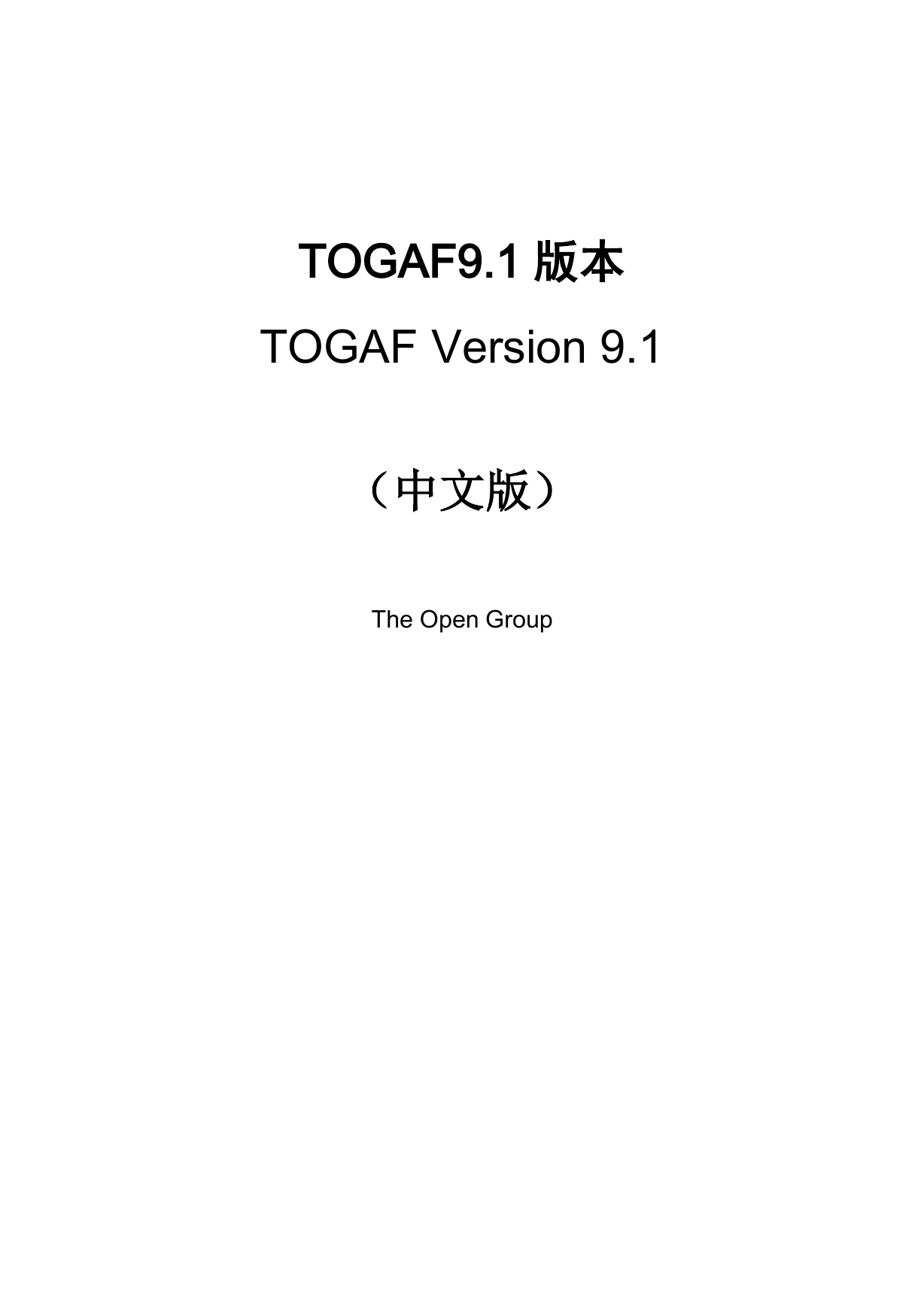
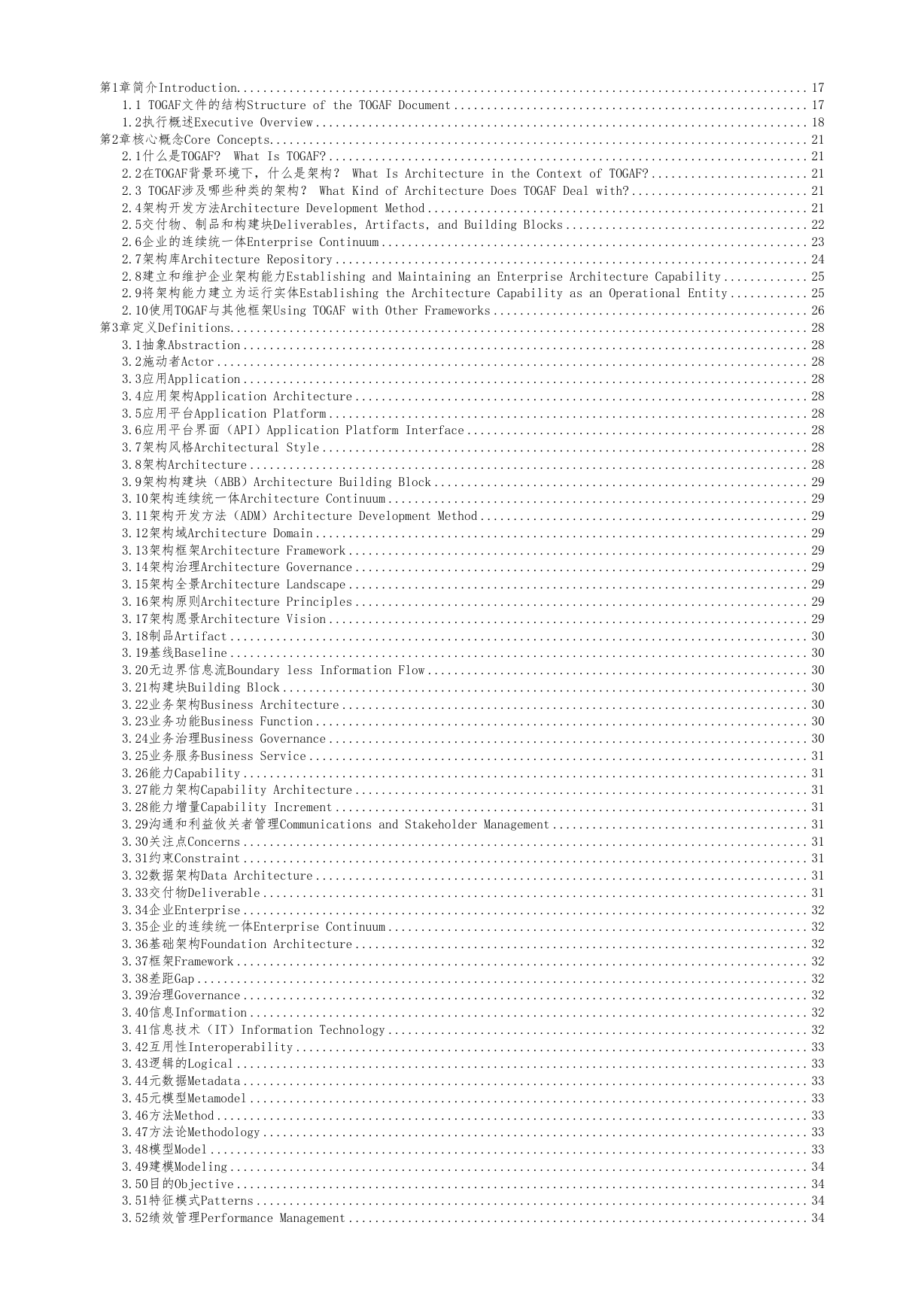

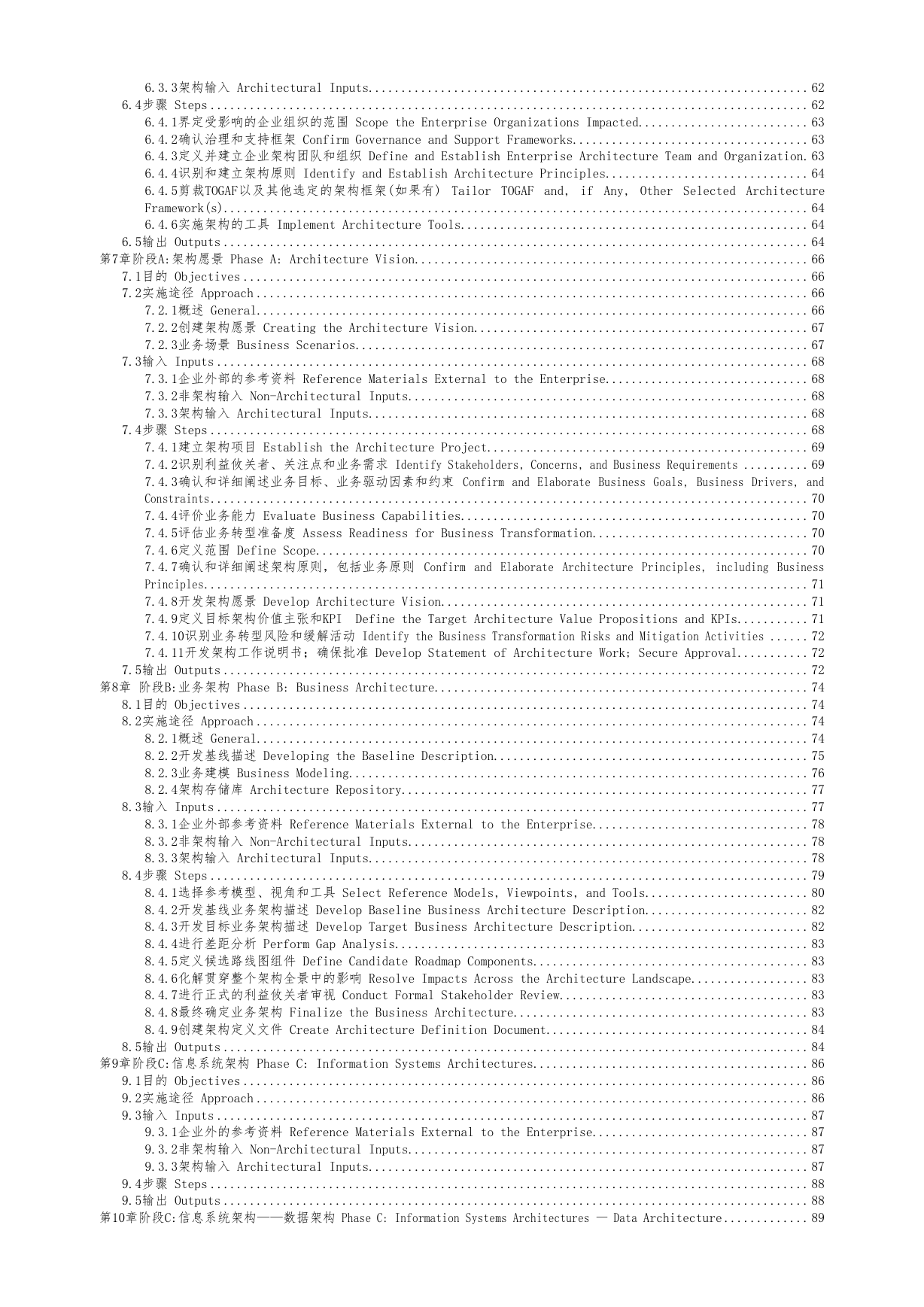
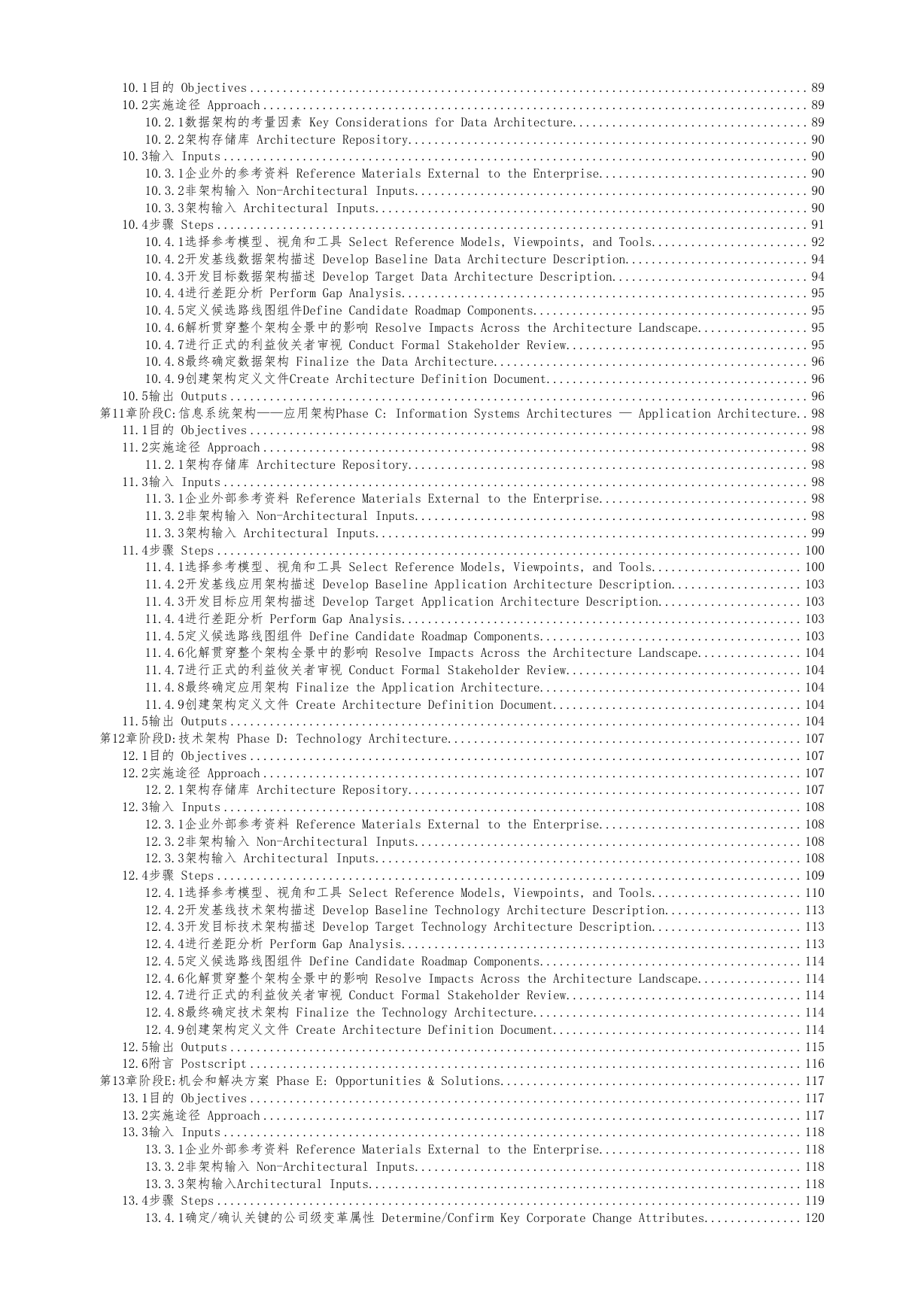
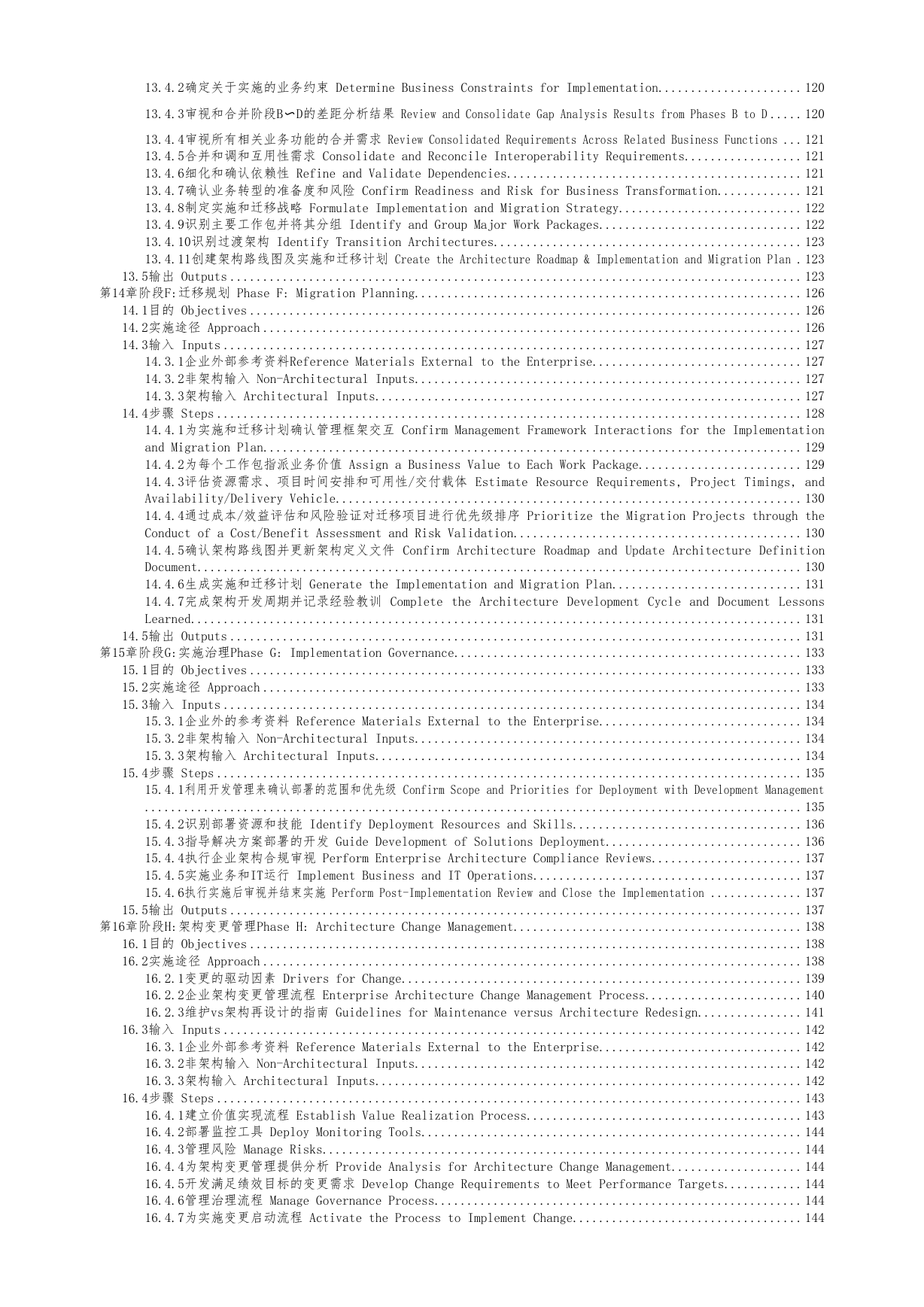
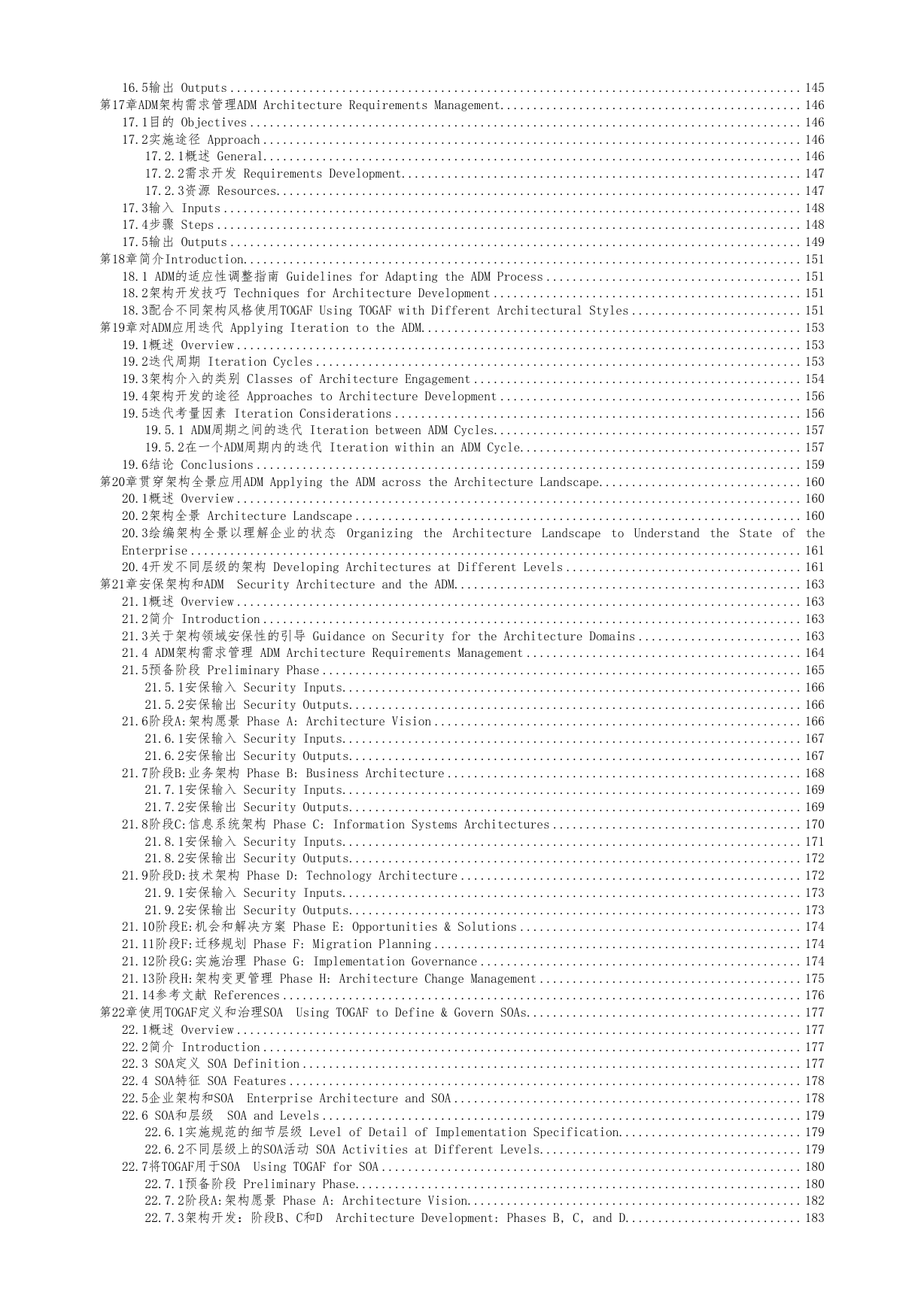
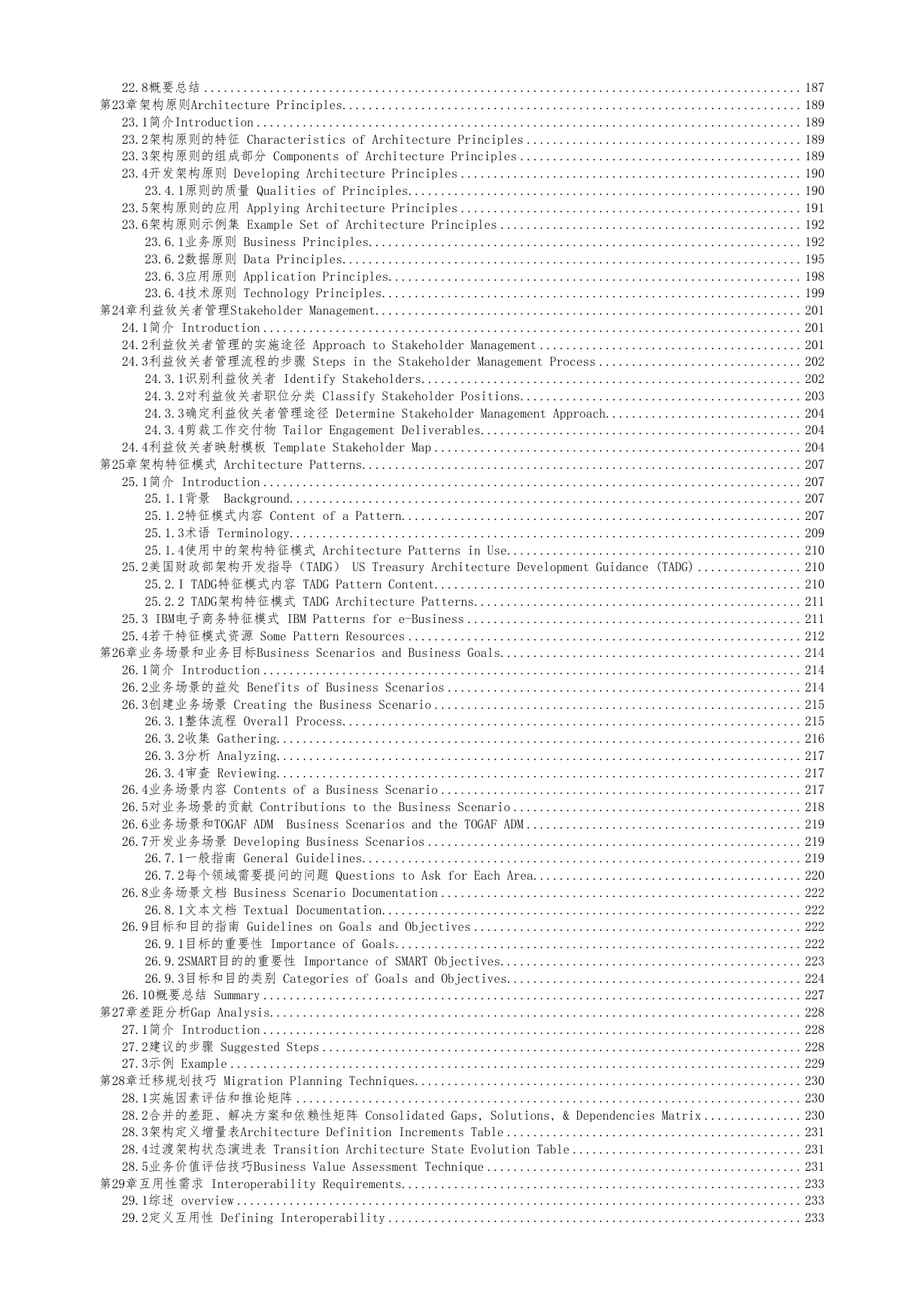








 2023年江西萍乡中考道德与法治真题及答案.doc
2023年江西萍乡中考道德与法治真题及答案.doc 2012年重庆南川中考生物真题及答案.doc
2012年重庆南川中考生物真题及答案.doc 2013年江西师范大学地理学综合及文艺理论基础考研真题.doc
2013年江西师范大学地理学综合及文艺理论基础考研真题.doc 2020年四川甘孜小升初语文真题及答案I卷.doc
2020年四川甘孜小升初语文真题及答案I卷.doc 2020年注册岩土工程师专业基础考试真题及答案.doc
2020年注册岩土工程师专业基础考试真题及答案.doc 2023-2024学年福建省厦门市九年级上学期数学月考试题及答案.doc
2023-2024学年福建省厦门市九年级上学期数学月考试题及答案.doc 2021-2022学年辽宁省沈阳市大东区九年级上学期语文期末试题及答案.doc
2021-2022学年辽宁省沈阳市大东区九年级上学期语文期末试题及答案.doc 2022-2023学年北京东城区初三第一学期物理期末试卷及答案.doc
2022-2023学年北京东城区初三第一学期物理期末试卷及答案.doc 2018上半年江西教师资格初中地理学科知识与教学能力真题及答案.doc
2018上半年江西教师资格初中地理学科知识与教学能力真题及答案.doc 2012年河北国家公务员申论考试真题及答案-省级.doc
2012年河北国家公务员申论考试真题及答案-省级.doc 2020-2021学年江苏省扬州市江都区邵樊片九年级上学期数学第一次质量检测试题及答案.doc
2020-2021学年江苏省扬州市江都区邵樊片九年级上学期数学第一次质量检测试题及答案.doc 2022下半年黑龙江教师资格证中学综合素质真题及答案.doc
2022下半年黑龙江教师资格证中学综合素质真题及答案.doc